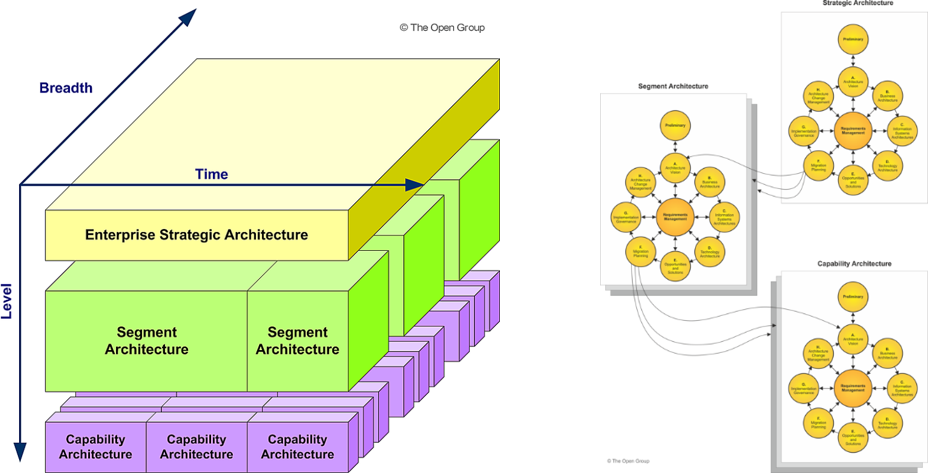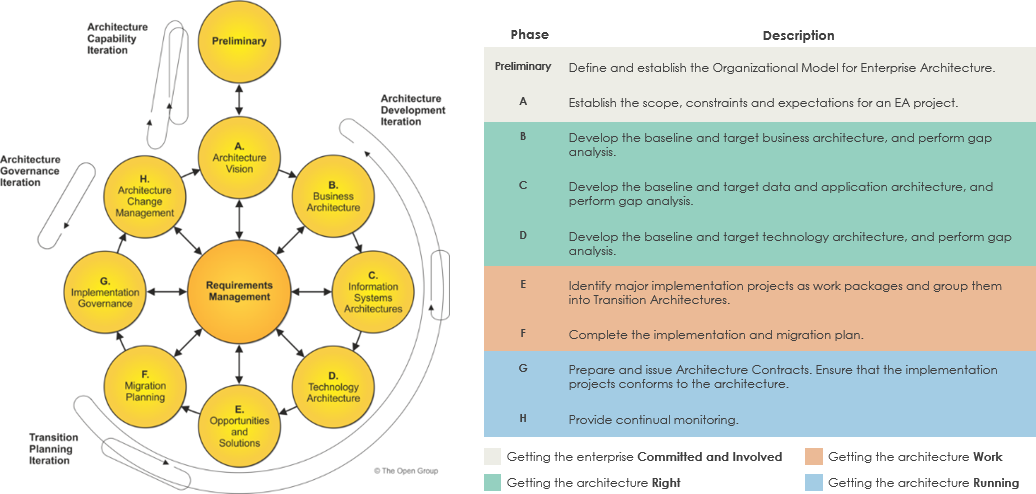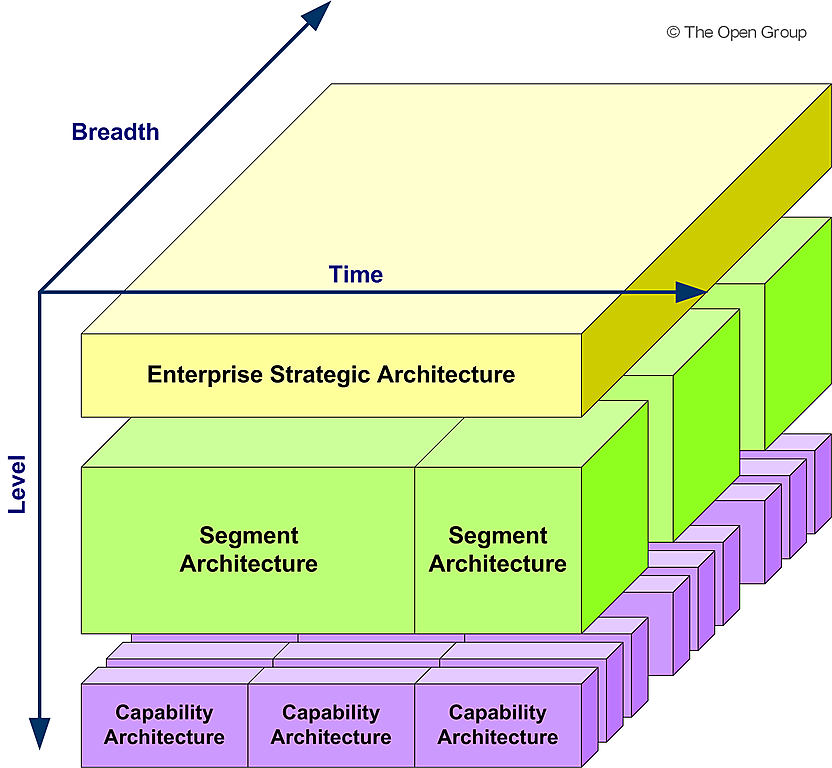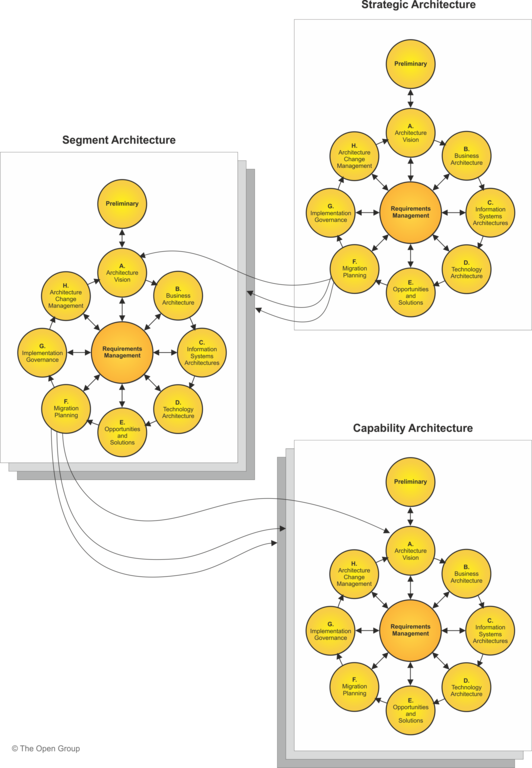Guidelines for Applying Iterative Cycles to the TOGAF ADM
The Architecture Development Method (ADM) is a key component of the TOGAF framework, which provides a comprehensive approach to enterprise architecture development. The ADM provides a structured approach for developing and managing enterprise architectures that align with business objectives and meet stakeholder needs. To maximize the benefits of the ADM process, it is important to understand how it can be adapted to meet the specific needs of an organization.
The TOGAF ADM Guidelines provide practical guidance for adapting the ADM process to deal with a range of different usage scenarios, such as incorporating iterative approaches, adapting for specific architectures, different process styles, and organizational structures. By following these guidelines, organizations can optimize their enterprise architecture development process and improve the alignment of their architectures with business goals.

Guidelines for Adapting the ADM Process:
- Applying Iteration to the ADM: This guideline explores the concept of iteration and its potential benefits when applied to the ADM process. It outlines various strategies for incorporating iterative approaches into the ADM, including incremental development and agile methodologies. The guideline also provides recommendations for selecting appropriate iteration approaches based on the needs of the organization.
- Applying the ADM across the Architecture Landscape : This guideline focuses on the different levels of architecture engagement within an enterprise and how the ADM can be adapted to support these different levels. It provides guidance on how to tailor the ADM process for specific types of architecture engagement, such as strategic planning or project delivery. The guideline also highlights the importance of aligning the ADM with the organization’s overall business strategy.
- Adapting the ADM for Specific Architectures: This guideline provides recommendations for adapting the ADM process to accommodate specialized architecture domains, such as security or data architecture. It outlines the unique considerations and challenges associated with these domains and provides guidance on how to integrate them into the ADM process effectively.
- Adapting the ADM for Different Process Styles: This guideline explores the various process styles that can be used in conjunction with the ADM process, such as lean or Six Sigma methodologies. It provides recommendations for integrating these process styles into the ADM and highlights the potential benefits of doing so.
- Adapting the ADM for Different Organizational Structures: This guideline addresses the challenges associated with adapting the ADM process to suit different organizational structures, such as those with decentralized decision-making or those with highly centralized governance models. It provides recommendations for tailoring the ADM process to fit these structures and suggests approaches for managing stakeholder engagement in these contexts.
Applying Iteration to the ADM
The concept of iteration is a critical component of the Architecture Development Method (ADM) within the TOGAF framework. There are three key ways in which iteration is used to support the ADM process.
The TOGAF ADM suggests a set of iteration cycles that can be used to effectively group related architectural activities to achieve a specific purpose.
The TOGAF ADM provides a structured framework for developing and implementing an enterprise architecture. It is divided into phases and iterations, with each iteration representing a logical grouping of related activities that are designed to achieve a specific purpose. The recommended iteration cycles for the TOGAF ADM are:
- Preliminary Phase: This phase is focused on establishing the business case for enterprise architecture development, identifying the stakeholders and their concerns, and defining the scope of the enterprise architecture effort.
- Architecture Vision Phase: This phase is focused on developing a high-level view of the enterprise architecture, including the business goals, strategic drivers, and key business requirements.
- Business Architecture Phase: This phase is focused on developing a detailed view of the organization’s business architecture, including the business processes, organization structure, and business capabilities.
- Information Systems Architecture Phase: This phase is focused on developing a detailed view of the organization’s information systems architecture, including the data architecture, application architecture, and technology architecture.
- Technology Architecture Phase: This phase is focused on developing a detailed view of the organization’s technology infrastructure, including the hardware, software, and network components.
- Opportunities and Solutions Phase: This phase is focused on identifying and evaluating potential solutions to address the business requirements and achieve the enterprise architecture goals.
- Migration Planning Phase: This phase focuses on developing a comprehensive plan for transitioning from the current architecture to the target architecture.
- Implementation Governance Phase: This phase is focused on establishing the governance framework for managing the implementation of the enterprise architecture.
- Architecture Change Management Phase: This phase is focused on managing the changes to the enterprise architecture over time, including monitoring the implementation of the architecture, and making changes as needed.
These iteration cycles can be customized and repeated as necessary to meet the specific needs of the organization and to achieve the desired outcomes.
- Architecture Development Iteration – The iteration is used to describe the process of developing a comprehensive Architecture Landscape through multiple ADM cycles, each of which is focused on individual initiatives within the scope of the Request for Architecture Work.
- Transition Planning Iteration – The iteration is used to describe the integrated process of developing an architecture, where the activities within different phases of the ADM interact to produce an integrated architecture. This type of iteration is often described in sequential terms to clearly define the activities and outputs.
- Architecture Governance iterations – The iteration supports the governance of change activity that is progressing towards a defined Target Architecture.
- Architecture Capability Iteration – The iteration is used to describe the process of managing change to the organization’s Architecture Capability, where continuous improvement is achieved through ongoing iteration and refinement of the ADM process. By incorporating these iterative concepts into the ADM process, organizations can enhance their architecture development capabilities and ensure that their architectures remain aligned with their evolving business needs.

Architecture Landscape and Iterative Cycles
In a typical enterprise, there can be many different architectures described in the Architecture Landscape at any given time. These architectures may address specific needs or provide a broader, more general view of the organization’s overall architecture.
To help manage this complexity, the TOGAF standard uses the concepts of levels and the Enterprise Continuum. Levels refer to the different levels of detail in the Architecture Landscape, ranging from high-level strategic architectures to more detailed technical architectures. The different levels of architecture are organized hierarchically, with higher-level architectures providing guidance and constraints for more detailed architectures.
The Enterprise Continuum is another conceptual framework used in TOGAF to organize the Architecture Landscape. It provides a way to classify and organize different architectures based on their level of abstraction and the degree to which they are standardized or customized. The Enterprise Continuum includes four levels: the Architecture Continuum, the Solutions Continuum, the Industry Continuum, and the Organization Continuum.
By using these frameworks, TOGAF provides a structured approach to organizing the Architecture Landscape, helping organizations to manage complexity and ensure that all architectures are aligned with business goals and objectives.

Different stakeholder needs at different levels of the organization require different types of architecture, and each architecture must be placed within a governance hierarchy. Broad, summary architectures set the direction for narrow and detailed architectures, ensuring alignment with business goals and objectives.
To achieve this, the ADM process can be used in two different strategies:
- Architectures at different levels can be developed through iterations within a single cycle of the ADM process. This approach involves developing architectures at different levels within the same cycle of the ADM process, using iteration to refine and develop the architectures as required.
- Architectures at different levels can be developed through a hierarchy of ADM processes, executed concurrently. This approach involves using multiple instances of the ADM process, each focused on a different level of architecture. The ADM processes are executed concurrently, with each level of architecture informing and guiding the development of the other levels.
Both of these strategies can be used to develop architectures at different levels within an organization, depending on the specific needs and circumstances. By using the ADM process, organizations can ensure that all architectures are developed in a structured and consistent way, and that they are aligned with overall business goals and objectives.
The Iterative Approach to Architecture Development in TOGAF’s ADM Cycle and Level
The TOGAF framework uses an iterative approach to the Architecture Development Method (ADM), which involves completing each phase of the ADM cycle at a single level of Architecture Description. Once an ADM cycle is completed at a particular level, the results are reviewed, and any necessary changes or updates are incorporated into the next cycle at that level or in a subsequent cycle at a different level.
The use of Phase F (Migration Planning) to initiate new, more detailed architecture development projects is one way that the TOGAF framework facilitates this iterative approach. In this way, higher-level architecture is used to guide and constrain more detailed architecture development, ensuring that the overall architecture landscape is consistent and aligned with business goals and objectives.
It’s important to note that the complete Architecture Landscape is not developed in a single ADM cycle but rather through multiple iterations of the ADM and possibly in different levels. This iterative approach allows for the ongoing refinement and improvement of the architecture over time, ensuring that it remains relevant and effective in meeting the evolving needs of the organization.

- The number of iterations required for a particular iteration cycle in TOGAF can vary depending on the complexity of the architecture development project and the level of stakeholder involvement. Some iteration cycles may only require a single iteration, while others may require multiple iterations to achieve the desired outcome.
- It’s also important to consider the appropriate checkpoints within the process, depending on the level of stakeholder involvement. For example, if stakeholders are highly involved in the architecture development process, frequent and informal checkpoints may be necessary to ensure that the project is on track. On the other hand, if stakeholders are less involved, checkpoints may be less frequent but more formal.
- Common checkpoints in TOGAF include those at the completion of each iteration cycle or at the end of several iteration cycles. These checkpoints help to ensure that the architecture development project remains aligned with the overall business goals and objectives, and any necessary adjustments can be made as required.
Summary
This article provides a comprehensive guideline for organizations to apply iterative cycles to the TOGAF ADM in order to maximize the effectiveness of their enterprise architecture development efforts. The guideline would outline the key principles and best practices for using iterative cycles in the TOGAF ADM, including how to tailor the iteration cycles to the specific needs of the organization and how to integrate feedback from stakeholders throughout the development process. The ultimate goal of the guideline would be to help organizations achieve their enterprise architecture objectives more efficiently and effectively by leveraging the power of iterative development methodologies.
In summary, developing architectures at different levels within an organization requires a structured approach that takes into account the different stakeholder needs and the need for alignment with overall business goals and objectives. To achieve this, the TOGAF standard provides two strategies that can be employed:
- Architectures at different levels can be developed through iterations within a single cycle of the ADM process, allowing for the development of architectures at different levels within the same cycle.
- Architectures at different levels can be developed through a hierarchy of ADM processes, executed concurrently, with each level of architecture informing and guiding the development of the other levels.
Both strategies allow for the development of architectures at different levels of detail and abstraction, ensuring that all architectures are aligned with business goals and objectives and that they sit within a governance hierarchy.

